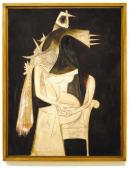The National Museum of Fine Arts.An oasis of shapes and colors
The most important collection of Cuban art of all time rubs elbows with genuine treasures of the universal plastic arts housed in a couple of buildings in Havana, two outstanding architectural gems that harbor the National Museum of Fine Arts
A few weeks ago Dr. Zahi Hawass, an eminent Egyptologist and one of the greatest men on the face of the earth fully devoted to the realm of museology and collecting, paid a visit to Havana. The nation’s capital historian Dr. Eusebio Leal said that when Mr. Hawass visited the National Museum of Fine Arts and saw the ancient collection, he expressed: “the man who did this knows a lot about museums.” The Egyptian collector, Mr. Leal went on to say, was far more astounded because, as he put it, “he hasn’t been able to do something like this in Cairo.” This letter of introduction is good enough to come closer to a flagship institution of Cuban culture: the National Museum of Fine Arts with 95 years of age under its belt —it was founded in 1913. With a treasure that surpasses 47,000 pieces, including paintings, sculptures, drawings, engravings, archeological installations and artifacts, this State-run institution was reopened back in 2001 following a costly all-out remodeling process that rejuvenated the two main exhibition buildings: the Palace of Fine Arts and the former Asturian Center of Havana that’s been part of the museum since then. The hundreds of thousands of visitors who have since then walked past its turnstiles find in both buildings –now equipped with high-tech lighting and security systems, better air-conditioning and indoor climate control- a genuine oasis of shapes and colors that start with the buildings’ architecture, two magnificent examples of one of Latin America’s most remarkable urban compounds. The Palace of Fine Arts —opened in 1954— was specially built as a museum based on a progressive design in which modernity and the purest traditional colonial architecture melt into one another. This place is home to the Cuban Collection, penciled in as the most complete and exhaustive in the world, marked by a parade of artistic expressions and laid out in four major stages: the Colonial Period, the New Century, Modern Art and Contemporary Art. Artworks made in the 16th century and such boldface names as Armando Menocal, Leopoldo Romañach, Victor Manuel, Carlos Enriquez, Amelia Pelaez and Marcelo Pogolotti share the space with the likes of Rene Portocarrero, Mariano Rodriguez and Wilfredo Lam, all the way to Raul Martinez, Antonia Eiriz and Alfredo Sosabravo, and eventually to contemporary artists like Mendive, Bedia, Nelson Dominguez, Zaida del Rio, Fabelo, and Kcho, among many others. For its part, the majestic building of the former Asturian Center (1927) is an outspoken and fancy instance of Spanish-inspired eclectic architecture. This building harbors the collection of Universal Art, a blend of styles, locations and epochs with standouts for the Hall of Ancient Art —the largest in Latin America and featuring vast and well-outfitted sections devoted to Egypt, Greece and Rome. The European sample embraces artworks from the traditional schools of Italy, Flanders, Holland, Spain, France and Great Britain, coupled with exhibits out of Asia, North America and the old schools of Mexico, the Antilles and South America. The Spanish collection —labeled by experts as one of the most important of its kind outside Spain— comprises such heavyweights as Zurbaran, Murillo, Paret Alcazar, Los Madrazo, Sorolla and Zuloaga, plus the chalcographic works of Goya and Fortuny. The National Museum of Fine Arts in Havana is no doubt an institution that oozes out life and presents an interesting cultural programming. Its information center, the theater, the audiovisual hall, the chamber, its stores and cafeterias guarantee further studies and research, professional exchanges, the purchase of good copies, the watching of a movie, the tasting of an ice cream or the enjoyment of a concert. The hands and hearts of a highly professional staff have turned this place into a paradise of culture and leisure.
































